Physical fitness is usually measured in
- Strength
- Speed
- Power
- Stamina
What we sometimes miss out on is the ability to move our joints through their full range of motion.
This will not only help increase the measures of physical fitness listed above, but it will also ensure you stay pain free.
Regardless of your background and athletic ability, you need to have good joint mobility. We all need to function in a world that requires us to move, bend, turn and defy gravity everyday.
Today we will talk about getting your mobility back. Despite what you may think, you all once had full range of hip mobility. Think back to how a baby can squat down and keep his heels on the floor. That is the perfect form we are shooting for.
Although you can suffer from a lack of mobility at any joint, the most common site is the hips. To put it simply, we sit down too much. I’m sitting down right now typing out this article. When you are sitting down you are putting your body in a tough position. Your hip flexors are in a shortened state, which will lead them to be chronically tight. Alternatively, your glutes are on stretch and slowly weaken. The big issue here for those that have been regular readers of Laurens Fitness is back pain. When you have inactive glutes and tight hip flexors your back takes over a lot of movements. The problem here is that the lower back is not designed for such stress. It is there for stability. When you have poor hip mobility as a consequence of sitting too much, tight hips and a weak posterior chain you are ensuring that your lower back will do a lot of extra work through everyday tasks.
Despite your athletic prowess I bet you need to walk up stairs, pick up your kids and carry your groceries right? To get the most out of your joints, you need them to be mobile. When you have a good hip range of motion, you will stop putting yourself at risk for chronic back pain and many other injuries due to poor biomechanics.
If you are an athlete, weekend warrior or someone who enjoys the occasional jog then this is even more important to you. You want to attain the ability to move your joints through their full range of motions, with strength and power. All of the attributes of physical fitness mentioned above will be compromised if you struggle to move your hips correctly. Your hips are the biggest power generators of your body, when they don’t function well you will significantly impair your performance in many athletic endeavours. If you fix your hip mobility, you will instantly find an increase in your squat and deadlift. You will see a big decrease in back pain, hip pain and many other injuries.
We spoke about how bad hip mobility can effect up the chain (the back), but the same goes for lower down the chain. If your hips don’t move correctly, your knees and ankles may have to take up the slack during certain movements. I have big knee issues and am recovering from a surgery on my right knee. My hips get tight and aggravated very easily. If I do a single leg squat and have pain, I can work with a tennis ball on my TFL and Glute Med, retest the single leg squat and I don’t have pain.
Everything is attached, your hips are the power epicenters of your body and when they aren’t functioning that is a lot of slack for the rest of your body to take up.
Let’s take another quick look at the benefits of getting that hip mobility back:
- Increase your hip mobility and you will have better squatting and athletic movements.
- Better hip mobility will ensure better glute activation.
- You can decrease the likelihood of back pain.
- You will decrease the chance of injuries lower down the chain (knee and ankle).
- Keep your joints healthy by taking them through a full range of motion.
Simple Hip Mobility Tests To Find Out Where Your Problem Lies
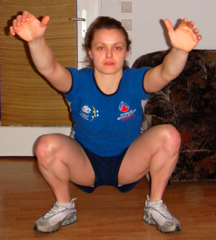
The first test you need to do is a full squat.
Can you get into the position shown in the photo?
This isn’t the be all end all of hip mobility. Sometimes people are limited at the ankle (many injuries and bad range of motion) and I know personally right now my knee (surgery rehab) does not bend completely so this position is impossible. However, if you are healthy and your ankles are ok, this will generally show you if you have a lot to work on or not.
Moving on.
Although there are many reasons you may suffer from a lack of joint mobility, I am going to look at one commonly known and one not so commonly known way that might be affecting your hips and how to test them. Keep in mind all the tricks I give you later relate to these, so make sure you run through them all.
Number 1
You may simply have tight muscle and tight hip flexors, in which case stretching and self massage in that areas will help a lot. To test that out, lay on a table. Grab your knee and let the other leg hang. If your other leg falls down and touches the table then you generally are ok throughout the hip flexors. If you other hip and leg stays up off the table then you know you need to do some work on the hip flexors.
If you do have tight hip flexors and you stretch, feel better and a few days later have more problems, never fear. The next solution plus the 17 tricks I am giving you will ensure you have great hip mobility that lasts. Remember you may have other muscles causing you tightness and lack of range, although slightly less common we will address them all later.
Number 2
Now I have an interesting concept for you. You may be suffering from stability problems which is the root cause of your lack of mobility.If you have been stretching your hips until the cows come home and haven’t seen improvements, this might be the issue.
Now, understand that you should have a good range of motion as there shouldn’t be any tension on these joints. This is a ball and socket joint, which means it should be able to move as it pleases. If you struggle to get these ranges then there is a movement or stabilisation restriction. Most likely your core muscles suck and your pelvic area is weak, you can’t stabilize your hip and other muscles like your psoas go crazy to help to compensate for the lack of stability.
Similarly, if you are always tight and sore but seem to have good mobility then you probably lack stability and the muscle surrounding the area are working extra hard all of the time.
If you have poor stability in the core area then muscles surrounding go into overdrive to help stabilize the pelvis. The muscles on the outside of the hip work to stabilize during external rotation (foot outwards) and the muscles on the front of the body work during internal rotation (foot inwards). The reason we talk about this is because if you have a stability issue, you will find that planks and other exercises found below will really help you get more mobile, without actually doing any stretching or dynamic movement at the hips. This will ensure that you stimulate these muscles and ensure that they all work together, rather than overcompensating and putting tension on the muscles that stop your hips moving.
If you want to understand it better and see a live example from someone who really knows what he is doing check out this video. He also performs the internal and external rotation test that you can get somebody to help you with.
Courtsey of Dean Somerset.
If you know you are struggling with hip mobility, but you can’t really define what the issue is don’t stress. Try all of the tricks below and you will very quickly find out what helps you. Likewise, if that all went over your head just scroll down and get started! They all work together nicely, and when you improve stability and loosen the tissues around the area you will find you are moving better in no time.
All these tips and tricks are easy to incorporate into any warm up or cool down. They don’t take a lot of time to complete, and as you run through them you will find that some are more effective than others for you.
17 Tricks To Improve Your Hip Mobility
Stretches For Tight Hips
These stretches will help you improve the range of motion at your hips and discover points of tightness.
Hip Flexor Stretch
If you have tight hips, chances are your hip flexors are playing a part. They attach onto your femur (upper leg bone) as well as onto your lower back. If you think about squatting, as you are moving down your hip flexors will be pulling on your lower back and bringing it forward, limiting mobility. Try this hip flexor stretch and make sure you hold it for at least 30 seconds on each side. Check out my popular kindle book for under $3 that focusses on getting rid of tight hip flexors.
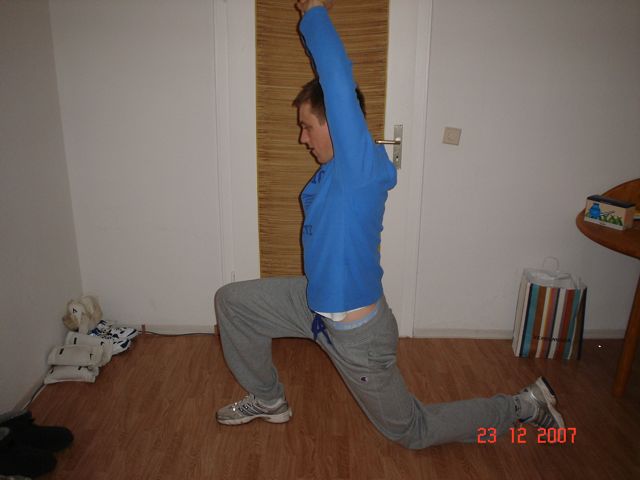
Hip Mobility Stretch
This is a great way to really open up your hips and get into all the little areas traditional stretches won’t let you, plus its got an added functional bonus ensuring you can move around and really open up as far as you can. Just get to a table or a couch, put your foot up onto it and move your knee around. If you find an area tighter than another just hang out in there and give it some extra attention.
Elevated Glute Stretch
This will really smash up your piriformis, which can get super tight and aggravted. Not only that, because your other leg is on the ground you will be getting a good stretch through your other hip flexor at the same time.
Self Massage For Tight Hips
Sometimes stretching isn’t enough to get rid of tight tissues. Luckily you can do a lot of self massage work at home, by yourself. Before you finish this post make sure you check out my Self Massage Guide for all this stuff in a lot more detail.
Tennis Ball Psoas
This is a no brainer and something all of you should try. Your psoas is the most troublesome of your hip flexors and can cause all kinds of issues regarding hip mobility and back pain. Place a tennis ball about 2 inches from your belly button to the left or the right and lie down on it. Most people will find they need to elevate the ball, a book works well. if you have a soccer ball or something of similar size, you can also lay on that for a wider and less intense pressure.
If you feel yourself tight through that area just hang out there. It takes time to release muscle and fascia so camp out and take deep breaths in and out. Every time you breathe out you will find yourself with a little more range of motion.
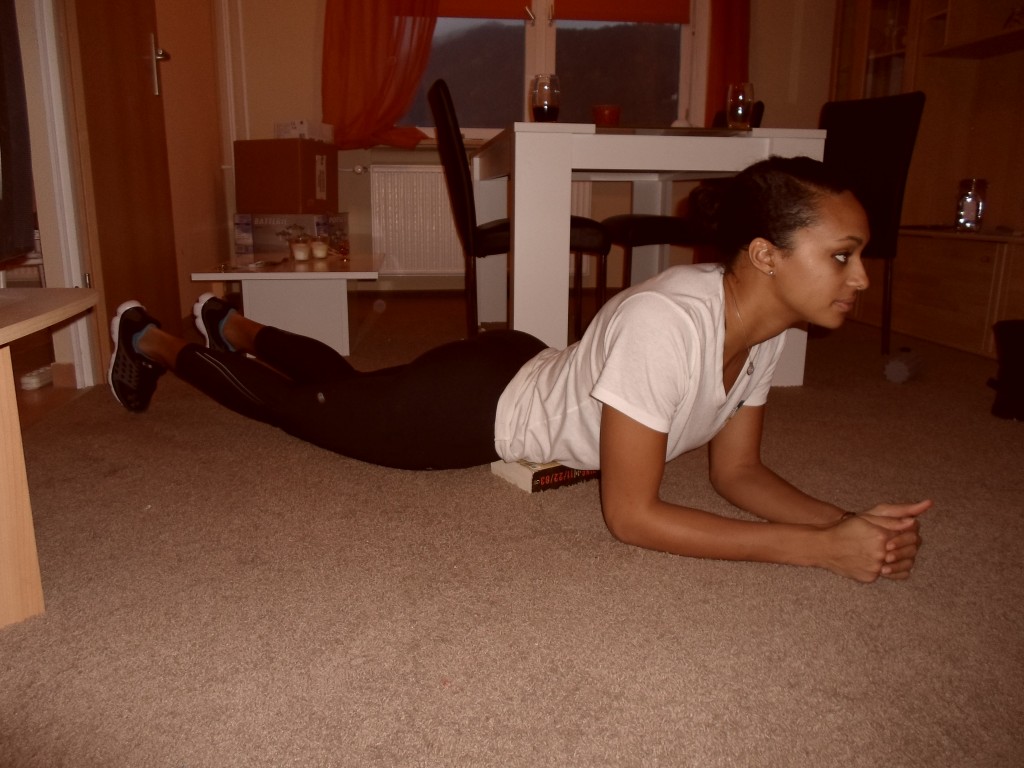
Tennis Ball Glute Med
Your glute med is responsible primarily for outward rotation of the hip and you need it functioning properly if you want good hip biomechanics. The muscle is used in a lot of daily movements (i.e heavily prominent when walking) and can get tight and aggravated on many people. Not only will it limit your hip mobility, you will also find you suffer from back pain, knee pain and hip pain.
Your glute med attached to the top of your hip bone and sits slightly towards the back of your body. To find it move your hand around to find the crest of your hip, and bring your hand back and slightly down. If you are tight you will instantly feel how this muscle affects you. Lie on the floor propped up on your elbows and place the ball in that area. Move around slowly, make sure you cover the whole muscle. If you find something that gives you a nasty referring pain, hang out on it, you might have hit a trigger point.

Tennis Ball TFL
Your TFL turns into your ITB. Which is the huge band of fascia that runs down the side of your leg. The TFL has huge implications in hip mobility and can often cause a pinching feeling if it is tight and aggravated. This is an area that most people will need to release and can be quite painful.
To hit this the TFL, lie on your side and place the tennis ball directly under the crest of your hip bone. This is quite a small muscle so you will know once you hit it. Take deep breaths in and when you release try to relax your body a little more over the ball.

Tennis Ball/ Foam Roll Adductor
Your adductors are your groin muscles. These can obviously restrict hip mobility if they aren’t functioning properly. In my opinion this is utterly the most painful place to do soft tissue work. Beware.
Lie on your front with one knee out to the side. Place a tennis ball on a book to elevate it (or a foam roller, it’s a little nicer to begin with) and ensure you get a deep enough massage. I recommend starting closer to the knee (these are really long muscles so you need patience) and working up towards the groin area. You will find trigger points in here easily, so don’t forget to camp out on them. They will release, despite what your body tells you!
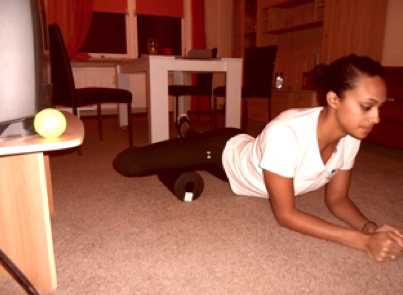
Piriformis
Mentioned above in the elevated hip stretch this nasty little muscle can stop hip mobility progress in its tracks. Sit down and place one ankle over the other bent knee as in the picture. Place the tennis ball just outside the point of your bum, and slowly lower yourself. Move around until you find the spot, this muscle is tiny and hidden between a couple others but in this position you are exposing it.
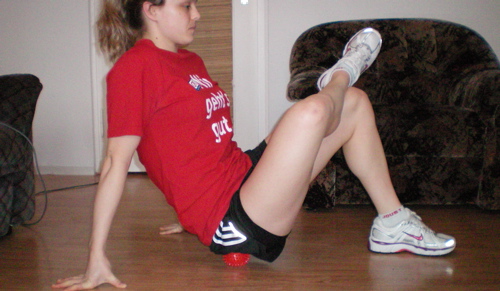
Hip Mobility Exercises
What’s the best way to get better hip mobility? Move those damn hips right through their full range of motion. These exercises will focus on getting your hips mobile and bendy.
Elbow To Instep Lunge
Every time I make a team or client do this I love to listen to the noises come out of their mouths. This is a lunge that ensures you get stuck into every hip range of motion possible and will really stretch you out. Take a look at the video below.
Leg Swings
A very simple way to take your hips through complete front and side range of motion. Hold onto a chair or a wall and swing your leg up as high as you can, do the same behind. Turn to the side and really work through that range of motion.
Squat To Stand
I like this exercise because in my opinion the squat is the biggest test of hip mobility there is. This will take you in and out of the range that you need to be in. Although my model here is very flexible, you can put your feet slightly wider apart, move your arms in between your legs and point your toes out to get extra range at the start. Not all of us are strong and flexible enough to do what she is doing.
OH Lunges
If you have read a lot of my stuff you know these are a staple in my programs. They stretch out your fascia, strengthen your lower body and give you a great dynamic hip range of motion exercise. Hold anything overhead and lunge forward slowly. Make sure your arms are straight and your knees do not go over your toes when you step out.

Side Lunges
Another variation of the lunge that can help you get more range in a different plane of motion. Step out to the side and lower yourself as far as you can. You will find yourself improving in terms of strength very quickly. Your range of motion and hip mobility will soon follow.
Hip Stability Exercises
As we mentioned above, sometimes it’s not just the fact that you are tight that stops you having good hip mobility. If you are weak and unable to stabilize your hips and core, you throw your biomechanics out the window and start to compensate. You end up restricting your mobility and it’s all because of a weak core.
Bird Dogs
This is a simple yet very effective exercise that you can do to help get strong around the hip area. Start on all fours and slowly lift the opposite arm and leg. Tense your glutes as you bring your leg up and hold for a second at the top. Check out the video.
Bridges
The bridge is the ultimate glute exercise and you need to be doing it. It hits all of your glutes and really challenges your posterior chain to take over and stop letting your back come into play (which greatly inhibits hip movement). If you need to start with two legs you can, but I will show you the one leg variety to really challenge your core and hips. Start on your back with one knee bent and one in the air. Push through the heel of your foot to lift your bum off the floor. Your body should be in a straight line. Repeat around 10 times.

Side Plank
Now we are talking about interesting concept number 2 from above. The muscles you use in a side plank play a large role in providing lateral stability to the spine. These muscles also resist internal rotation (foot outwards in the original test). You will be stimulating these muscles and ensuring that they work together with the rest of your body and stop you compensating. For many people mastering the side plank will help increase range of motion in the hip very quickly and it all has to do with resetting your hip biomechanics. You can start on your knee and move up to your foot. Hold the position for as long as you can until your form breaks.

Front Plank
Similarly to the side plank, the front plank will help you increase your pelvic stability without using your hip flexors. If you squeeze your bum while you perform this exercise, you can ensure your hip flexors stay out of it and the abs can work with the surrounding core muscles to stabilise your spine and pelvis. This is ideal and will ensure that you won’t be actively resisting external rotation (foot inwards in original test) and will quickly regain some hip mobility.
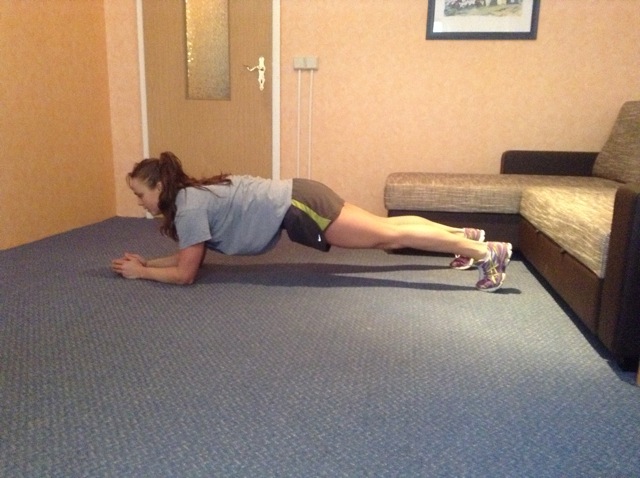
Did you test out all of the tricks? Which tips worked best for you?
Jeet says
Great tips! I use most of them. Will add the rest too.
Thanks
Lauren says
Thanks Jeet! Good to see you around again 🙂
Suzanne says
Thanks Lauren, this is really useful. I’m an ancient runner and have ‘issues’ with my hip mobility. These are great practical no fuss tests/stretches.